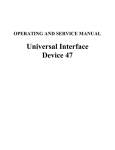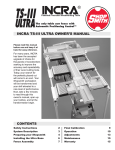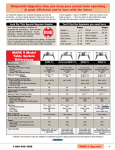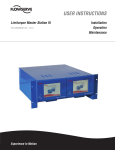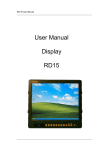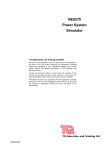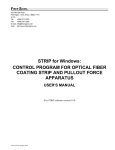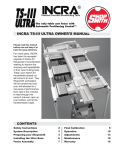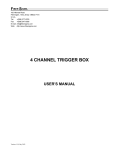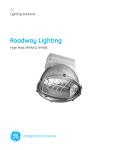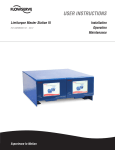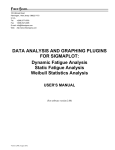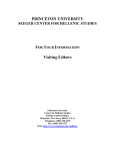Download UID46: Universal Interface Device User`s Manual
Transcript
OPERATING AND SERVICE MANUAL Universal Interface Device 46 MAGNA-POWER ELECTRONICS, INC. 39 ROYAL ROAD, FLEMINGTON, NJ 08822 September 5, 2009 SAFETY NOTICE Universal Interface Device 46 (UID46) connects two or more power supplies for master/slave configurations or for other user configured applications. Before applying power to the system, verify that the system is configured properly for the specific application and that ratings are not exceeded on any input or output terminal. Installation and service must be performed only by properly trained and qualified personnel who are aware of dealing with electrical hazards. Ensure that the ac power line ground is properly connected to the power supply chassis. Furthermore, other power grounds, including those connected to application maintenance equipment, must be grounded for both personnel and equipment safety. Always ensure that facility ac input power is de-energized prior to connecting or disconnecting the input and output power cables. Caution: While the UID46 is a low voltage device, lethal voltages may be present inside the connecting power supply even when the ac input voltage is disconnected. Only properly trained and qualified personnel should remove covers and access the inside of the power supply. During normal operation, the operator does not have access to hazardous voltages within the cabinet. Depending on the user’s application, high voltages hazardous to human safety may be generated normally on the output terminals of the connecting power supply. Ensure that the output power cables are properly labeled as to the safety hazards and that any inadvertent contact with hazardous voltages is eliminated. The connecting power supply is designed to be permanently connected to the power source requiring a readily accessible disconnect device incorporated in the fixed wiring. These operating instructions form an integral part of the equipment and must be available to the operating personnel at all times. All the safety instructions and advice notes are to be followed. Neither Magna-Power Electronics, Inc. nor any of the associated sales organizations can accept responsibility for personal injury, consequential injury, loss, or damage that results from improper use of the equipment and accessories. i LIMITED WARRANTY The following is made in lieu of all warranties expressed or implied. Magna-Power Electronics, Inc. warranties its products to be free of manufacturing defects for a period of two (2) years from date of original shipment from its factory. Magna-Power Electronics, Inc. will repair, replace, or refund the purchase price at its discretion, which upon examination by Magna-Power Electronics, Inc., is determined to be defective in material or workmanship, providing such claimed defective material is returned upon written authorization of Magna-Power Electronics, Inc., freight prepaid. For products failing within the first 30 days of the warranty period, Magna-Power Electronics, Inc. will return the repaired product at its expense using a standard shipping method; after 30 days of the warranty period, the repaired product will be returned at the customer’s expense using the customer’s requested shipping method. Damage due to corrosion, customer alterations, excessive dust, extreme environmental or electrical conditions, and/or misuse will be evaluated upon inspection. If inspection reveals that the cause of damage is not due to materials or workmanship, repair of the product will be treated on a non-warranty basis. All electrical, commercial supply parts, and items not manufactured by Magna-Power Electronics, Inc. shall carry the warranty of the original manufacturer and no more, but under no circumstances to exceed the warranty period. Replacement parts shall be warranted for a period of 90 days. Warranty labor shall only apply if the product, assembly, or part is returned to the factory freight prepaid and insured. Damage or breakage while in transit is not covered by this warranty. Magna-Power Electronics, Inc. assumes no responsibility to Buyer for labor to diagnose and remove defective product and installation of replacement product. Furthermore, Magna-Power Electronics, Inc. is not liable to Buyer or to any third party for consequential or incidental damages under any circumstances, whether due to defect in the product, due to delay or failure of delivery, due to a failure of the product to perform as specified, or for any other reason or cause. Buyer and Magna-Power Electronics, Inc. agree that Buyer’s sole remedy and Magna-Power Electronics, Inc.’s sole liability to Buyer is limited to repair, replacement, or refund of the purchase price of the product as described herein, whether Buyer’s claim arises out of contract or in tort. All claims against the warranty shall be the final determination of Magna-Power Electronics, Inc. ii CLAIM FOR DAMAGE IN SHIPMENT This instrument received comprehensive mechanical and electrical inspections before shipment. Immediately upon receipt from the carrier, and before operation, this instrument should be inspected visually for damage caused in shipment. If such inspection reveals internal or external damage in any way, a claim should be filed with the carrier. A full report of the damage should be obtained by the claim agent and this report should be forwarded to us. We will then advise you of the disposition to be made of the equipment and arrange for repair or replacement. When referring to this equipment, always include the model and serial number. RETURNING EQUIPMENT Before returning any equipment to the factory, the following steps should be taken: 1. Contact our technical service department. Give a full description of the difficulty and include the model and serial number of the unit. On receipt of this information, we will give you service information or shipping instructions. 2. Packaging and method of shipment must be coordinated with the factory to insure safe delivery. All equipment returned for repair require a Return Authorization Number and must be insured. No returns will be accepted without assignment of a Return Authorization Number. 3. For non-warranty repairs, we will submit a cost estimate for your approval before proceeding. iii TABLE OF CONTENTS Section Title Page 1.0 GENERAL INFORMATION 1.1 Description 1.2 Features 1.3 IEC Symbols Used in Manual 1.4 Power Requirements 1.5 Specifications 1 1 1 1 1 1 2.0 INSTALLATION AND OPERATION 2.1 General 2.2 Master/Slave Parallel Operation 2.3 Master/Slave Series Operation 2.4 Custom Configurations 4 4 4 7 8 iv 1.0 GENERAL INFORMATION 1.1 Description This manual contains operation and maintenance instructions for Magna-Power Electronics' Universal Interface Device 46 (UID46). The UID46 allows users to connect power supplies for master/slave parallel or series operation or allows connections to external control circuitry with easy access screw terminals. 1.2 Features The UID46 is a general purpose device for connection to Magna-Power Electronics’ XR, TSiii, MSiii, and MTiv Series power supplies. The device contains the necessary circuitry for configuring power supplies for master/slave parallel or series operation. Master/slave parallel operation allows two or more power supplies to equally share output current when connected together. Master/slave series operation allows two or more power supplies to equally share output voltage when connected together. The UID46 can be used as an interface for connecting control and monitoring lines to external circuitry. It also contains an area on the printed circuit board for interconnecting wires and placing components for specific user applications. 1.3 IEC Symbols Used in Manual The following IEC symbols are used in this manual. Caution, risk of electric shock Caution, risk of danger Protective conductor terminal Three-phase alternating current 1.4 Power Requirements None 1.5 Specifications 1 The following specifications describe the published operational characteristics of the UID46. UID46 connectors, see figure 1.1 for details: JR1,2,3: 37 pin D-subminature, female JR4: 10 pin plug connector Size: 1.210"H x 7.140"W x 4.010"D, see figure 1.2 for details. Weight: 6.54 oz. Figure 1.1 UID46 connectors (a) JR1,2,3 and ( b) JS4 (viewed from UID46) 2 Figure 1.2 UID46 Enclosure 3 2.0 INSTALLATION AND OPERATION 2.1 General The UID46 is a general purpose device for connection between Magna-Power Electronics’ XR, TSiii, MSiii, and MTiv Series power supplies and user devices. Figure 2.1 shows the electrical circuit of the UID46 and figure 2.2 shows jumpers connections for master/slave parallel and series operation. The following sections describe how to use the device for master/slave parallel and series operation and for custom applications. Caution: As shipped, the UID46 is configured for master/slave parallel operation. 2.2 Master/Slave Parallel Operation Two or more Magna-Power Electronics’ power supplies can be connected in parallel to obtain a total output current greater than that available from one power supply. The total output current is the sum of the output currents of the individual power supplies. Each power supply can be turned on or off separately. Master/slave parallel operation permits equal current sharing under all load conditions and allows complete control of output current from one master power supply. To configure the power supplies for master/slave parallel operation, disconnect power to the power supplies and connect all units and loads in parallel as shown in Figure 2.3. Remove the cover of the UID46 and set the jumpers settings according to Figure 2.2 for master/slave parallel configuration. This is the factory default setting. Replace the cover and connect a 37-conductor male to male cable from connector JS1 of the master power supply to connector JR2 of the UID46. Connect a second 37-conductor male to male cable from connector JS1 of the slave power supply to connector JR1 of the UID46. The jumper settings perform the following functions: 1. Jumper connection between terminals 19,20 connects the current monitoring voltage, IO2, on the master power supply to the external current set point input on the slave power supply. This makes the slave power supply operate at the same current output as the master power supply 2. Jumper connection between terminals 11,12 connects the power output digital control line of the master power supply to the start digital control line of the slave power supply. This connection causes the slave unit to turn on when the master unit is turned on. 4 Figure 2.1 Schematic of UID46 (a) (b) Figure 2.2 Jumper JP1 settings for (a) master/slave parallel and (b) master/slave series 5 3. 4. Jumper connection between terminals 13,14 connects the standby/alm digital control line of the master power supply to the stop digital control line of the slave power supply. This connection causes the slave unit to turn off when the master unit is turned off or when a diagnostic condition appears. Jumper connections between terminals 3,4; 5,6; 7,8; 9,10; 15,16 set the slave voltage set point to maximum and the voltage trip and over current trip set points just beyond full scale values. The slave power supply must be configured for external program input. The master unit can be configured for rotary, keypad, external program, or remote input. Refer to the power supply manual for setting the configuration commands. Three or more parallel connected power supplies can be interconnected by applying additional UID46 units; one UID46 is required for every slave power supply. As illustrated in figure 2.3 for two slave power supplies, follow the previous instructions plus connect an additional 37conductor male to male cable from JS1 of the second slave power supply to JR1 of the second UID46. Connect a 37-conductor male to male cable between connector JR3 and JR2 of the two UID46 units. Interconnecting UID46 units routes master control and monitoring signals to all of the slave power supplies. Figure 2.3 Master/slave parallel connection for (a) one or (b) more slave power supplies 6 2.3 Master/Slave Series Operation Two or more power supplies can be connected in series to obtain a total output voltage greater than that available from one power supply. The total output voltage is the sum of the output voltage of the individual power supplies. Each power supply can be turned on or off separately. Caution: No plus or minus voltage should exceed 1000 Vdc with respect to ground for models rated 1000 V less. No plus or minus voltage should exceed 4000 Vdc with respect to ground for models rated greater than 1000 V. Master/slave series operation permits equal voltage sharing under all load conditions and allows complete control of output voltage from one master power supply. To configure the power supplies for master/slave series operation, disconnect power to the power supplies and connect all units and loads in series as shown in Figure 2.4. Remove the cover of the UID46 and set the jumpers settings according to Figure 2.2 for master/slave series configuration. Replace the cover and connect a 37-conductor male to male cable from connector JS1 of the master power supply to connector JR2 of the UID46. Connect a second 37-conductor male to male cable from connector JS1 of the slave power supply to connector JR1 of the UID46. The jumper settings perform the following functions: 1. Jumper connection between terminals 17,18 connects the voltage monitoring voltage, VO2, on the master power supply to the external voltage set point input on the slave power supply. This makes the slave power supply operate at the same voltage output as the master power supply 2. Jumper connection between terminals 11,12 connects the power output digital control line of the master power supply to the start digital control line of the slave power supply. This connection causes the slave unit to turn on when the master unit is turned on. 3. Jumper connection between terminals 13,14 connects the standby/alm digital control line of the master power supply to the stop digital control line of the slave power supply. This connection causes the slave unit to turn off when the master unit is turned off or when a diagnostic condition appears. 4. Jumper connections between terminals 1,2; 3,4; 5,6; 7,8; 15,16 set the slave current set point to maximum and the voltage trip and over current trip set points just beyond full scale values. The slave power supply must be configured for external program input. The master unit can be configured for rotary, keypad, external program, or remote input. Refer to the power supply 7 manual for setting the configuration commands. Three or more series connected power supplies can be interconnected by applying additional UID46 units; one UID46 is required for every slave power supply. As illustrated in figure 2.4 for two slave power supplies, follow the previous instructions plus connect an additional 37conductor male to male cable from JS1 of the second slave power supply to JR1 of the second UID46. Connect a 37-conductor male to male cable between connector JR3 and JR2 of the two UID46 units. Interconnecting UID46 units routes master control and monitoring signals to all of the slave power supplies. Figure 2.4 Master/slave series connection for (a) one or (b) more slave power supplies 2.4 Custom Configurations The UID46 permits users to design and implement their own control circuitry to control or monitor the power supply’s inputs or outputs. As shown in figure 2.5, the UID46 has a general purpose area on its printed circuit board to configure custom circuitry or to provide interconnections to utilize connector JR4. Table 2.1 shows the interface of master and slave connectors JR1 through JR3 with corresponding pad areas of JX1 and JX2. Connectors JR2 and JR3 are interconnected to allow daisy chain connections for multiple UID46 units. JR4 is a 10 terminal connector that mates to a screw terminal plug. This connector is user defined and can be utilized to externally monitor or control power supply functions. Table 2.2 shows the interface of connector JR4 and the corresponding pad area. For example, connecting a wire from terminal 1 of JX3 (USER1) to terminal 15 of JX1 provides a signal to indicate the master power 8 supply is operational. The multipurpose area in the center of the PCB enables the user to add circuitry within the UID46. The multipurpose area provides sufficient space to add components like or’ing diodes for simultaneously monitoring two diagnostic signals. One example is to connect the anodes of two diodes to the OCT and OVT alarm signal and interconnect the cathodes. This provides a diagnostic signal on either the OCT or OVT alarm signal. Table 2.1 JR1 JR2 JR3 1 2 3 4 5 6 7 8 9 10 11 12 13 14 15 16 17 18 19 CONNECTION INTERFACE DESCRIPTION FOR JR1, JR2, AND JR3 JX1 JX2 Description 1 3 5 7 9 11 13 15 17 19 21 23 25 27 29 31 33 35 37 REF GND REF GND VREF EXT TVREF EXT VO2 +2.5V REF CAL GND POWER THERMAL INTERLOCK CUR CTL STANDBY/ALM ALM EXT CTL FUSE RESERVE START CLEAR STOP JR1 JR2 JR3 JX1 JX2 Description 20 21 22 23 24 25 26 27 28 29 30 31 32 33 34 35 36 37 2 4 6 8 10 12 14 16 18 20 22 24 26 28 30 32 34 36 9 REF GND +10V REF IREF EXT TIREF EXT IO2 VMOD +5V PGM LINE STANDBY PHASE LOSS VOLT CTL RESERVE OCT INT CTL OVT RESERVE ARM INTERLOCK SET Table 2.2 JR4 1 2 3 4 5 6 7 8 9 10 CONNECTION INTERFACE DESCRIPTION FOR JR4 JX3 Description 1 2 3 4 5 6 7 8 9 10 USER1 USER2 USER3 USER4 USER5 USER6 USER7 USER8 USER9 USER10 Figure 2.5 Printed circuit board layout of the UID46 10


















